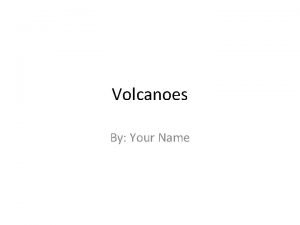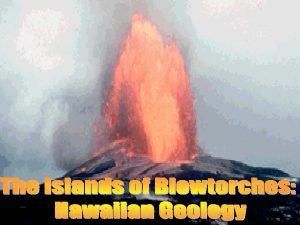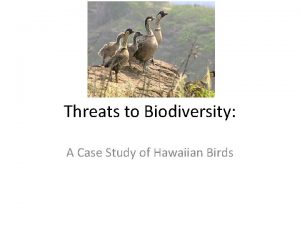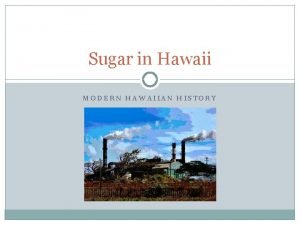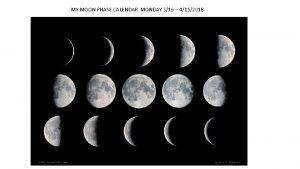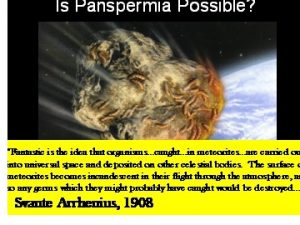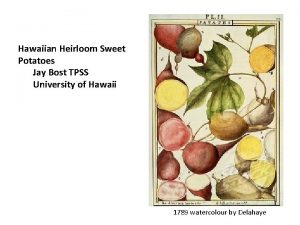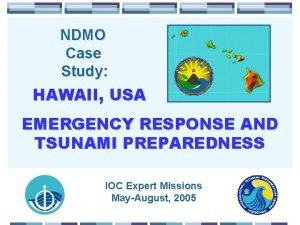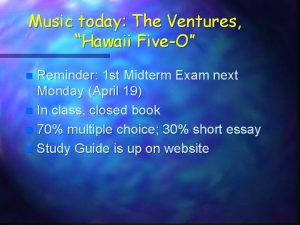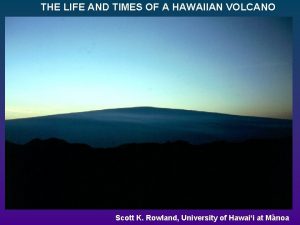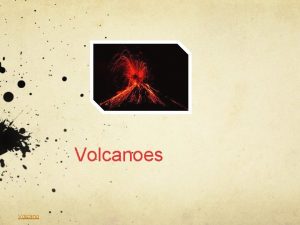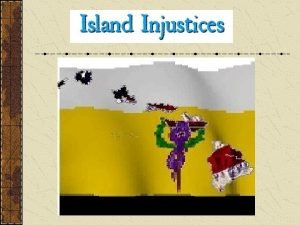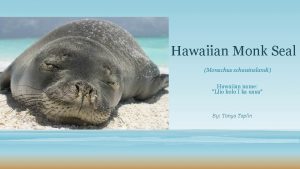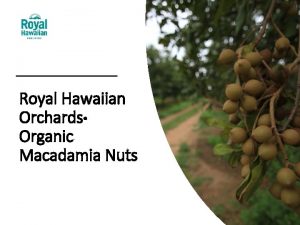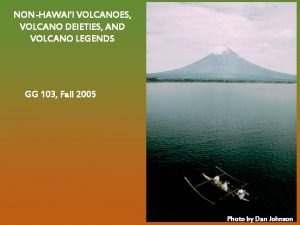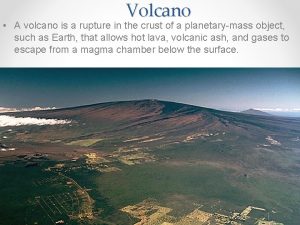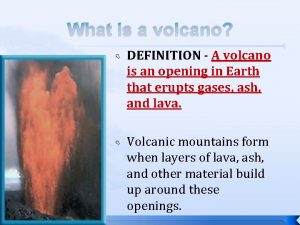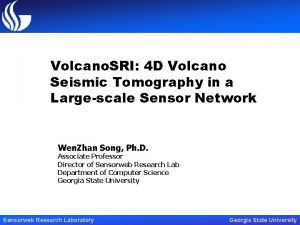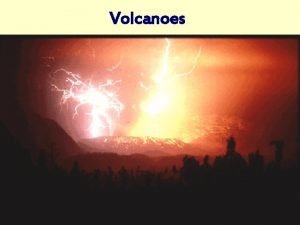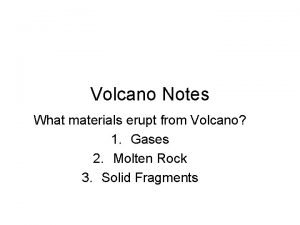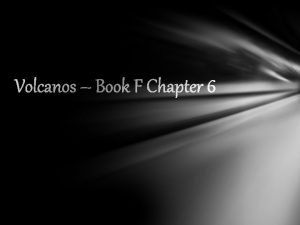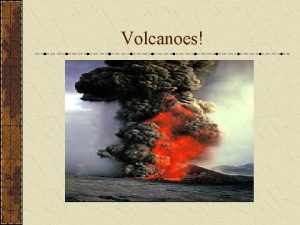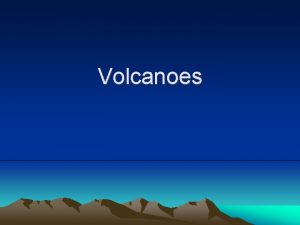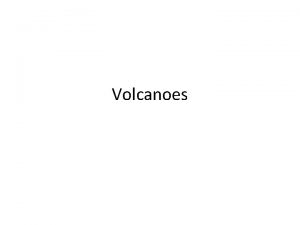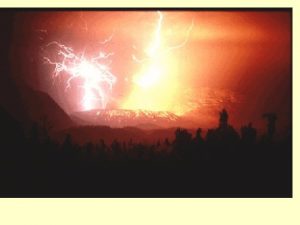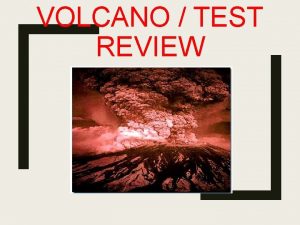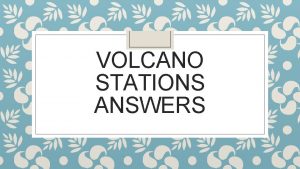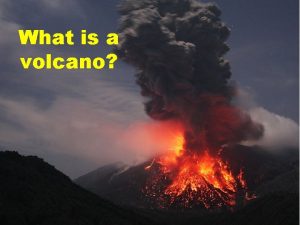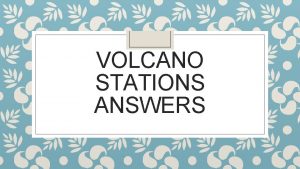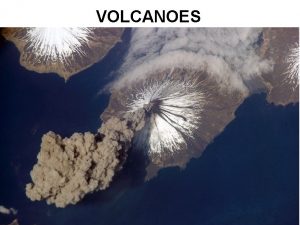THE LIFE AND TIMES OF A HAWAIIAN VOLCANO
































- Slides: 32

THE LIFE AND TIMES OF A HAWAIIAN VOLCANO Scott K. Rowland, University of Hawai‘i at Manoa

O‘ahu consists of two elongate shield volcanoes, Wai‘anae and Ko‘olau Wai‘anae

The “production line” model of Hawaiian volcano evolution. . .

--diagram by Chuck Blay & Robert Siemers


adapted from Peterson & Moore (1987)

Koko Rift, SE end of Ko‘olau Volcano, O‘ahu

N coast of E. Moloka‘i

actual avalanche scarps obvious cliffs from Moore (1964)

PYROCLASTIC ACTIVITY AND VENT STRUCTURES ON HAWAIIAN VOLCANOES

ERUPTION STYLES AND VENT FORMS

Expanding gas drives a lava fountain. The highest fountains in Hawai‘i are >500 m Technically, the base of the fountain is where the gas becomes 75% by volume, and this is usually 10 s to 100 s of meters below the vent rim.

- Pu‘u ‘O‘o scoria cone (in the early 1990 s)

Kupaianaha lava pond, Kilauea (1986 -1992) ~20 m

Mauna Iki satellitic shield, Kilauea SW rift zone


HYDROMAGMATIC ERUPTIONS (Kapoho, 1960)


Koko Rift rejuvenation-stage volcanism, Ko‘olau volcano, O‘ahu: -most of these eruptions occurred off the shoreline at the time -tuff cones, many nested and/or coalesced, resulted

“surge” deposits, from lateral, turbulent deposition

HAWAIIAN LAVA FLOWS Scott K. Rowland, University of Hawai‘i at Manoa

Lava flows: ‘a‘a and pahoehoe From Hawaiian Dictionary by M. K. Puku‘i & S. H. Elbert - 1. To burn, blaze, glow; fire; staring, as eyes. Fig. , angry, ‘a‘a: fury. Ua ‘a‘a- ‘ia au i ke aloha (I burn with love). 2. stony, abounding with ‘a‘a- lava. pahoehoe: 1. Smooth, unbroken type of lava. 2. Satin. 3. to drive fish into a net by beating the paddles rhythmically against the canoe.

‘a‘a- and pahoehoe flows on the north flank of Mauna Loa ~3 m

Wave-cut cliff section, Makapu‘u, O‘ahu

RIFT ZONES AND CALDERAS ON HAWAIIAN VOLCANOES Scott K. Rowland, University of Hawai‘i at Manoa

Rift zones have the form of broad topographic ridges, and are where flank eruptions occur Topography of Mauna Loa’s SW rift zone (dark flows post-date 1778)

If an eruption is going to occur along a rift zone somewhere, magma has to get there from the magma chamber. It does this as a blade-shaped body of magma called a dike. -Tracking the rock-breaking earthquakes allows geologists to determine that most dikes propagate at 1 -2 km/hour. -Harmonic tremor tells geologists that magma is continuing to flow underground. Next time you are near a large water pipe, put your hand on it and you will feel harmonic tremor.

Solidified dikes are exposed by erosion on older Hawaiian volcanoes

Kilauea caldera: Complex calderaboundary faults, and Halema‘u, (H) an intra-caldera pit crater 1954 lava flow H

Rift zones on O‘ahu are identified most easily by mapping dike swarms. Ko‘olau rift zone axes and caldera Wai‘anae rift zone axes and caldera

‘Olelo no‘eau involving lava (from M. K. Pukui; compiled by Ululani Makue) O ka la- ko luna, o ka pahoehoe ko lalo. The sun above, the smooth lava below. Said of a journey in which the traveler suffers because of the heat of the sun above and because of the reflected heat from the lava below (i. e. , a difficult trip). - uwe- ka mamane. Kīke- ke ‘ala, When the boulders clash, the mamane tree weeps. Meaning that when two people fight, those that are dear to them suffer. PAU

PAU
 Lava plateaus form when _____.
Lava plateaus form when _____. Factors of 168
Factors of 168 Hawaiian parrot fish
Hawaiian parrot fish Hawaiian history timeline
Hawaiian history timeline Threats to biodiversity a case study of hawaiian birds
Threats to biodiversity a case study of hawaiian birds History of sugar timeline
History of sugar timeline Hawaiian moon phases
Hawaiian moon phases Hawaiian monk seal adaptations
Hawaiian monk seal adaptations Hawaiian rules
Hawaiian rules Hawaiian kinship system
Hawaiian kinship system Hawaiian kinship system
Hawaiian kinship system Hot magma rises to the surface
Hot magma rises to the surface Hawaiian slingshot
Hawaiian slingshot Telling time in hawaiian
Telling time in hawaiian Jay bost
Jay bost Hawaiian pawg
Hawaiian pawg Hawaii five-o the ventures
Hawaii five-o the ventures Manawa hawaiian
Manawa hawaiian Jako kaasik
Jako kaasik Volcanoes on oahu
Volcanoes on oahu Prince escalus
Prince escalus Life and times of shakespeare
Life and times of shakespeare The life and times of an ant
The life and times of an ant Shakespeare life and times
Shakespeare life and times Hình ảnh bộ gõ cơ thể búng tay
Hình ảnh bộ gõ cơ thể búng tay Slidetodoc
Slidetodoc Bổ thể
Bổ thể Tỉ lệ cơ thể trẻ em
Tỉ lệ cơ thể trẻ em Chó sói
Chó sói Tư thế worm breton
Tư thế worm breton Hát lên người ơi
Hát lên người ơi Môn thể thao bắt đầu bằng từ chạy
Môn thể thao bắt đầu bằng từ chạy Thế nào là hệ số cao nhất
Thế nào là hệ số cao nhất
